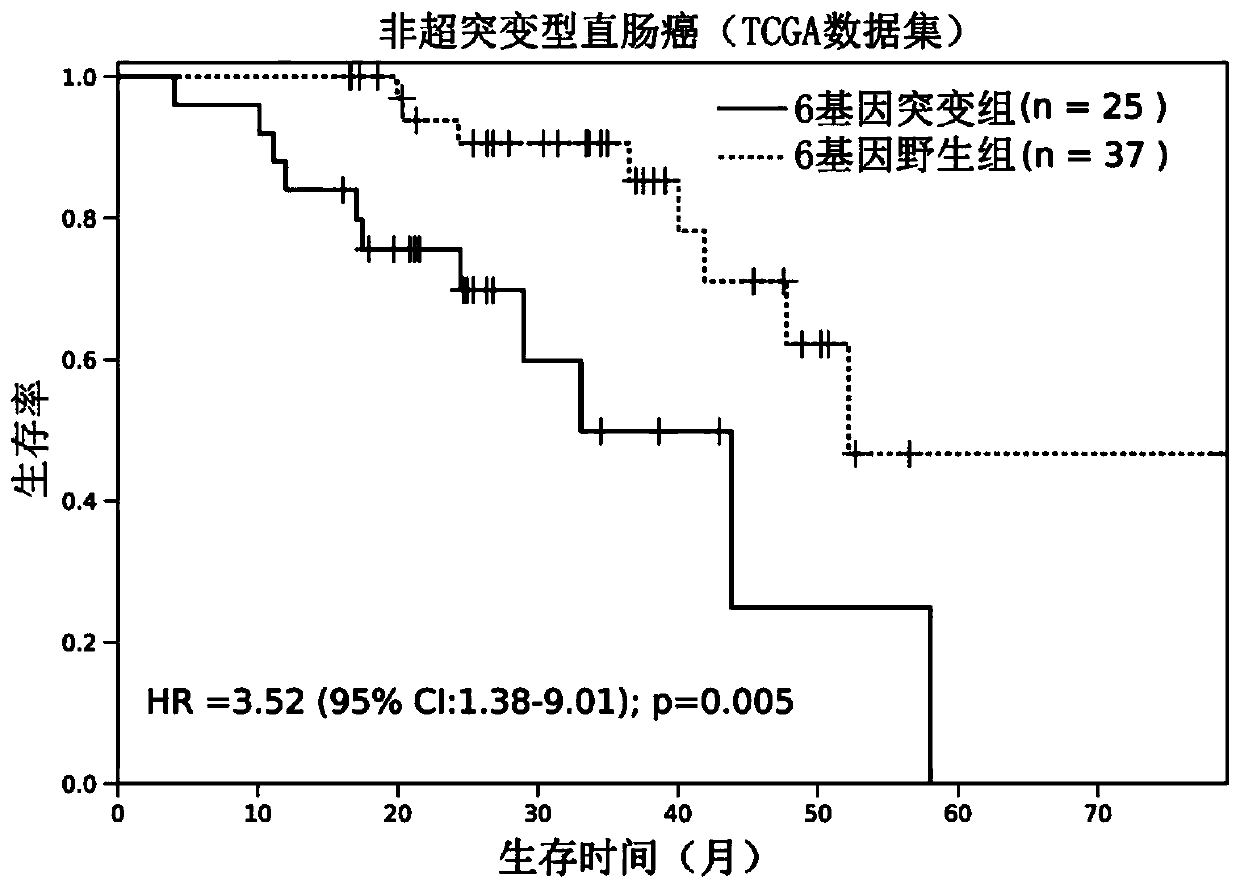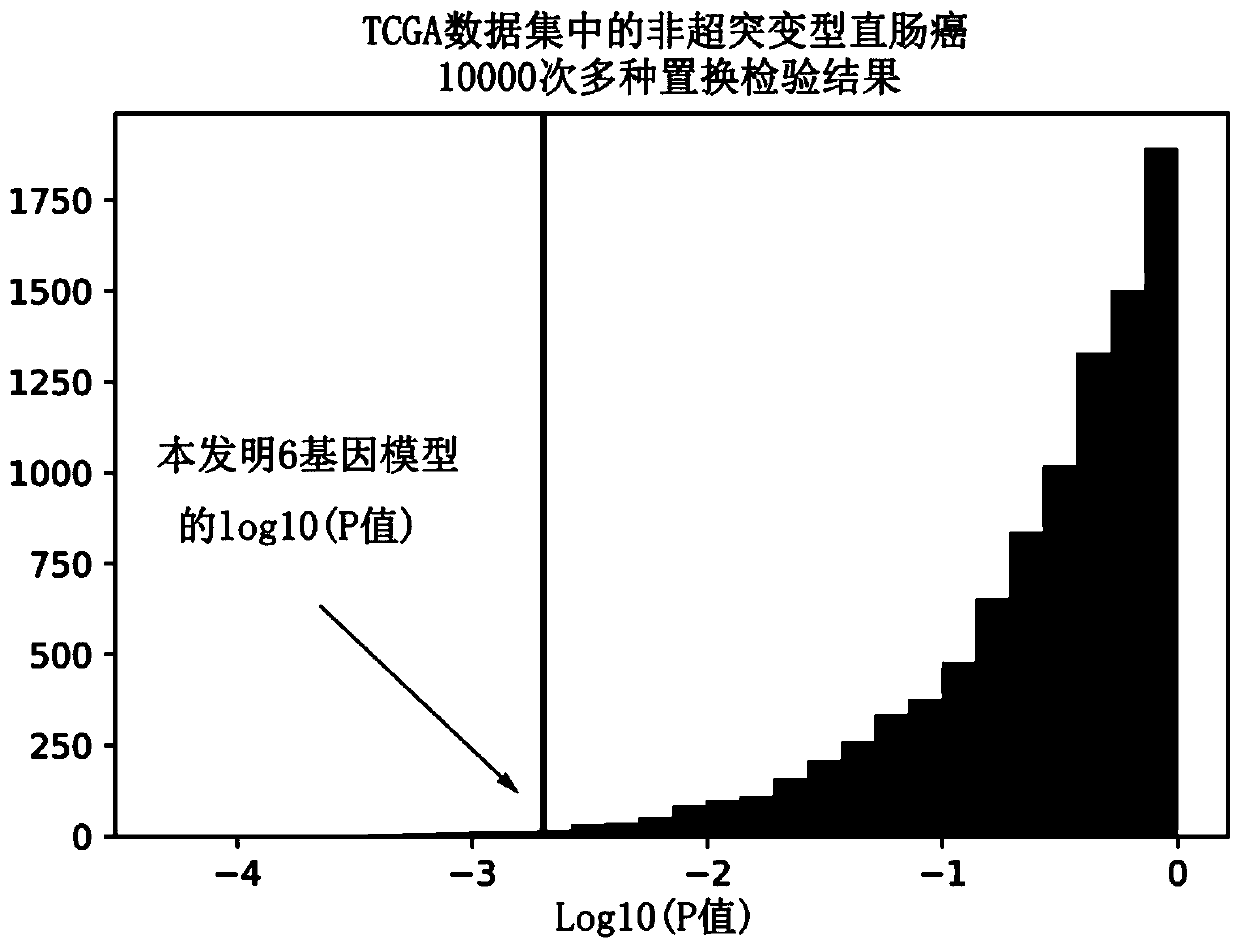Group of genes for molecular typing of non-hyper-mutant rectal cancer and application thereof
A technique of molecular typing and mutation type, applied in the prediction of postoperative recurrence and metastasis of rectal cancer, in the genetic field of molecular typing of non-hypermutated rectal cancer, can solve the problems of tumor recurrence or metastasis, patient death, etc. Achieve good clinical guidance and avoid over-treatment effects
- Summary
- Abstract
- Description
- Claims
- Application Information
AI Technical Summary
Problems solved by technology
Method used
Image
Examples
Embodiment 1
[0032] Example 1: Preparation of Genomic DNA Samples and Determination of Tumor Somatic Mutation Sites
[0033] In order to detect somatic mutations in rectal cancer, the present invention designed a gene group including 524 genes (Table 1), and customized capture probes for this gene group. Targeted sequencing of 157 rectal cancer tissue specimens was completed using this capture probe. All specimens were from surgically resected tissue specimens, and the excess part after pathological diagnosis was used for sequencing research. This work was approved by the Human Research Ethics Committee of the Second Affiliated Hospital of Zhejiang University School of Medicine. This part of 157 tumor patients is the ZJU data set.
[0034] Table 1: List of 524 genes
[0035]
[0036]
[0037]
Embodiment 2
[0038] Example 2: Establishment of a gene mutation prognosis prediction model for non-hypermutated rectal cancer
[0039]Since hypermutated and non-hypermutated rectal cancers are quite different in their pathogenesis, prognosis and curative effect, the present invention firstly divides rectal cancer patients into hypermutated and non-hypermutated two groups. Tumors with a mutation burden rate less than or equal to 10Mut / Mb were defined as non-hypermutated tumors. Of the 157 cases of rectal cancer (ZJU data set) in Example 1, 148 cases were determined to be non-hypermutated. In addition, in order to verify the stability and universality of the model, the present invention downloaded a total of 112 cases of rectal cancer data from TGCA as independent verification data (TCGA data set), and 107 cases were determined as non-hypermutated according to the same standard rectal cancer. Further, the present invention requires patient data with a follow-up period of more than 15 month...
Embodiment 3
[0041] Example 3: Analysis of postoperative mortality risk of non-hypermutated stage III rectal cancer using a six-gene prognostic prediction model
[0042] According to the AJCC cancer staging system commonly used in clinical practice, rectal cancer can be divided into stage 0 to stage IV, and the treatment options for different stages are quite different. Therefore, the present invention analyzes the stage III rectal cancer, which is more common clinically. The results showed that the six-gene model was significantly associated with postoperative survival time in stage III rectal cancer with a hazard ratio of 3.89 (95% confidence interval = 1.88-8.02, P Figure 4 , indicating that compared with patients in the 6-gene wild-type group, patients in the 6-gene mutant group had a worse prognosis and a higher risk of death. At the same time, there was no significant difference in the proportion of patients receiving postoperative adjuvant chemotherapy between the six-gene wild grou...
PUM
 Login to View More
Login to View More Abstract
Description
Claims
Application Information
 Login to View More
Login to View More - R&D
- Intellectual Property
- Life Sciences
- Materials
- Tech Scout
- Unparalleled Data Quality
- Higher Quality Content
- 60% Fewer Hallucinations
Browse by: Latest US Patents, China's latest patents, Technical Efficacy Thesaurus, Application Domain, Technology Topic, Popular Technical Reports.
© 2025 PatSnap. All rights reserved.Legal|Privacy policy|Modern Slavery Act Transparency Statement|Sitemap|About US| Contact US: help@patsnap.com



